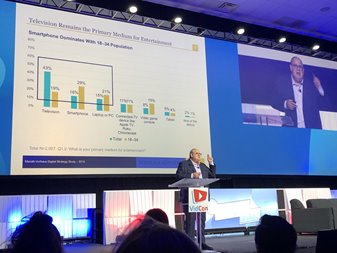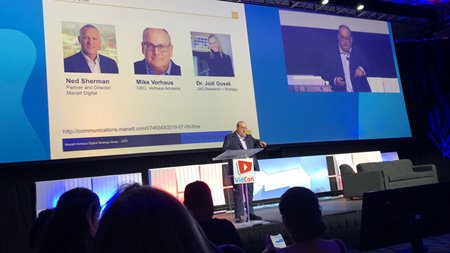If you were to take a quick snapshot of the digital video world in 2019, you’d see the pros and cons of peak TV, fewer legacy content companies (some with “new looks” as a result of M&A), and more places to consume content than ever before. Screens of all shapes and sizes, from smartwatches to smart TVs, are now prime real estate where content can be viewed and monetized. This explosion of digital video, which has been erupting for years now and shows no signs of being extinguished anytime soon, was on full display at VidCon, which turned ten years old this July. The tenth installment of the super conference—where YouTubers, industry executives, video fanatics and more gather to immerse themselves in all things digital video for four days—served as a significant mile marker for an industry that has seen one constant over the past decade: change.
When the first VidCon took place in 2010, the 1,400 attendees’ focus and excitement centered around optimizing their YouTube channels and some light programming about whether Facebook’s video tools were viable options for establishing and increasing a following. Fast forward to 2019 and you’ll see over 75,000 attendees gathered to enjoy, among other things, massive Fortnite and Facebook Watch LBE activations; discussions about deepfakes, news deserts and podcasts; and impromptu TikTok video shoots.
The topics and themes covered at VidCon 10 served as a perfect checkpoint for highlighting how far digital video has come over the past ten years, and how the industry is poised to look even more different ten years from today.
Interpreting Consumer Behavior
Recently, our consulting group partnered with Media & Entertainment veteran advisor Mike Vorhaus to conduct a study that analyzed the current state of media and content consumption. More than 2,000 consumers provided input for the study’s results, which Vorhaus shared on the main stage at VidCon. Our study showed that 72% of consumers between the ages of 18 and 34 use their smartphone to watch online video at least once a week. A 2011 Nielsen study showed that number to be around 11% in 2010 here in the U.S.


Mike Vorhaus presents the Manatt-Vorhaus Digital Strategy Study at VidCon 10.
This major shift to consumption of video on mobile devices was a contributor to the rise of over-the-top (OTT) video streaming services. In 2010 when VidCon was just launched, Netflix had only just begun to offer streaming video to its subscribers. Today, a plethora of options are available to stream movies, shows and live events. So how many more services like Netflix will consumers actually pay for today, and will they continue to pay for new services in the future? Our study showed that users are likely to sign up for 1.6 additional streaming services on top of the ones they already have (60% said they already have Netflix).
Watching how companies compete for this wallet and screen share over the next decade will be exciting, must-see content in itself. Will this stiff competition result in better content options and more favorable pricing for consumers? And with so many streaming options available, will the next decade see the cable bundle respawn itself into a single package of multiple OTT services?
IGTV—One Year Later
Last year Instagram introduced IGTV, the social media platform’s long-form video product. Instagram’s VP of business and media, Jim Squires, shared the VidCon stage with one of Instagram’s top influencers, Vincent Marcus, to discuss IGTV’s performance in Year 1 and IGTV’s future plans. Marcus had a lot of questions for Squires, pressing him about monetization within IGTV and how the platform could help influencers grow and engage larger audiences.
This interaction between a new media executive and content creator crystallized the paradigm shift of DIY video that took place within the past decade: an unassuming creative, who stumbled into making videos in recent years, is now generating significant revenues for himself thanks to a platform like Instagram, which launched a week after the first VidCon.
After Squires and Marcus left the stage, we asked Squires if there were plans to roll out original programming on IGTV, which would potentially thrust Instagram into the OTT waters with Netflix, Hulu and Amazon. Squires was noncommittal, pointing out that improving the platform and enhancing monetization opportunities for creators through commerce were his focuses at this time. However, one cannot help but think how tempting it will be for Instagram to leverage its more than 1 billion monthly active users (and climbing) as an audience for premium, original content over the next decade.
The New Media Executives
On July 8, 2010, the day before the first VidCon, LeBron James announced on live television his decision to leave the Cleveland Cavaliers to join the Miami Heat. This set off a media firestorm, including some backlash for Team LeBron, which made a conscious decision from that point to take ownership of controlling LeBron’s narrative in the media.
LeBron’s solution was a media company that would serve as a platform for athletes to speak directly to fans, unencumbered by broadcast network gatekeepers. That vision led to Uninterrupted and SpringHill Entertainment, digital-first and traditional production entities, respectively, that would eventually become significant Hollywood power players and templates for other athletes who would eventually launch their own production companies.
LeBron & Co.’s leap into Hollywood raised the tide for all boats (Tom Brady and A-Rod are producing, Kobe won an Oscar, Kevin Durant is wading in the NYC media waters, and Steph Curry recently had the No. 1 show during Primetime on Thursdays), and now in 2019, having a production company has replaced “the shoe deal” as the most coveted business venture for an athlete.
VidCon highlighted the rise of the athlete media executive with several engaging panel discussions featuring executives working for athletes and some athletes themselves. Baron Davis spoke at length from the main stage about his media company’s plan for building a global media enterprise. Asani Swann, the head of Carmelo Anthony’s production company, shared insights on how they have owned and operated a compelling YouTube channel over the past decade.
Jeron Smith and Erick Peyton, co-founders and executives of Curry’s Unanimous Media, spoke at length about the challenges and opportunities that face a well-known athlete running a media company. Smith was adamant that while Curry’s name holds weight in pitch meetings, the ingredients for a hit show are still necessary to receive green lights and series orders.
Olympian Adam Rippon spoke about the freedom and autonomy his media company enjoys by partnering with YouTube to distribute branded content that is uplifting and encouraging for underrepresented voices in the LGBTQ community.
The Next Decade and Beyond
For all the progress we’ve seen in digital video in the past decade, the next ten years could see a similar evolution. Technology advancements with 5G and augmented reality, and new platforms like Quibi, are expected to perpetuate the trend of consuming content on new platforms produced by a new type of creative. More connected devices will put more eyeballs on screens, creating an even more unprecedented demand for what will certainly rule the next decade: content, which is king.